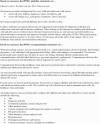The international Pediatric Oncology Exercise Guidelines (iPOEG)
- PMID: 34037786
- PMCID: PMC8604278
- DOI: 10.1093/tbm/ibab028
The international Pediatric Oncology Exercise Guidelines (iPOEG)
Abstract
Physical activity (PA) and exercise are safe and beneficial for children and adolescents affected by cancer. Yet, this population is not active enough to receive benefits. PA guideline and recommendation statements can support individual behavior and practice change. The purpose of this project was to develop the international Pediatric Oncology Exercise Guidelines (iPOEG), comprised of guideline and recommendation statements, to promote PA among children and adolescents affected by cancer. Guideline development procedures, stakeholder engagement strategies, and the Delphi technique were used. Four online surveys were distributed to the iPOEG network (n = 9 core team members, n = 122 expert consensus committee members). Surveys included closed- and open-ended items informed by a literature synthesis and an in-person meeting. Responses were analyzed using descriptive statistics and content analysis. Consensus was defined as ≥ 80% agreement. Response rates to online surveys ranged from 82% to 91%. The iPOEG network agreed on four guideline and five recommendation statements, which highlight that movement is important for all children and adolescents affected by cancer. These statements are generic in nature as more research is still required to provide specific guidance on the frequency, intensity, time, and type of PA for this population. Nevertheless, the iPOEG statements represent available evidence and expert opinion, collectively suggesting that it is time for children and adolescents affected by cancer to move more.
Keywords: Childhood cancer; Consensus; Delphi technique; Physical activity.
Plain language summary
Physical activity is safe and beneficial for children and adolescents affected by cancer. Yet, most are not active enough to receive benefits. Guideline and recommendation statements can help change individual behavior and practice. To develop such statements, guideline development procedures, stakeholder engagement strategies, and the Delphi technique were used. Four online surveys were distributed to an international network (n = 131 experts). Surveys asked closed- and open-ended questions informed by a literature synthesis and an in-person meeting. Findings from the online surveys resulted in the international Pediatric Oncology Exercise Guidelines statements, which highlight that it is time for children and adolescents affected by cancer to move more.
© The Author(s) 2021. Published by Oxford University Press on behalf of the Society of Behavioral Medicine.
Figures
References
-
- Baumann FT, Bloch W, Beulertz J. Clinical exercise interventions in pediatric oncology: A systematic review. Pediatr Res. 2013;74(4):366–374. - PubMed
-
- Grimshaw SL, Taylor NF, Shields N. The feasibility of physical activity interventions during the intense treatment phase for children and adolescents with cancer: A systematic review. Pediatr Blood Cancer. 2016;63(9):1586–1593. - PubMed
-
- Rustler V, Hagerty M, Daeggelmann J, Marjerrison S, Bloch W, Baumann FT. Exercise interventions for patients with pediatric cancer during inpatient acute care: A systematic review of literature. Pediatr Blood Cancer. 2017;64(11):1–5. - PubMed
-
- Morales JS, Valenzuela PL, Rincón-Castanedo C, et al. . Exercise training in childhood cancer: A systematic review and meta-analysis of randomized controlled trials. Cancer Treat Rev. 2018;70:154–167. - PubMed
Publication types
MeSH terms
LinkOut - more resources
Full Text Sources
Other Literature Sources
Medical



